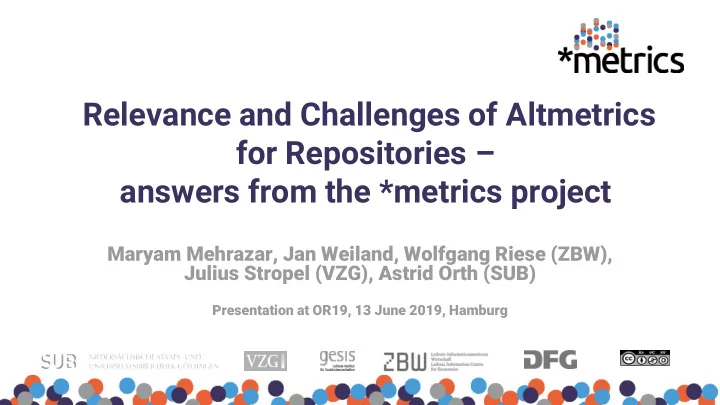

Relevance and Challenges of Altmetrics for Repositories – answers from the *metrics project Maryam Mehrazar, Jan Weiland, Wolfgang Riese (ZBW), Julius Stropel (VZG), Astrid Orth (SUB) Presentation at OR19, 13 June 2019, Hamburg
Outline 1. What can Altmetrics do for Repositories? 2. Answers from *metrics project 3. EconStor as a use case OR19, 13 June 2019, Hamburg 2
1. What can Altmetrics do for Repositories? Bibliometrics: Altmetrics/usage metrics (= web-based metrics): Timing: availability very early after publication of scientific results Access: greater openness, transparency, wider re-use than costly citation databases How often are scientific articles cited by other scientific articles? How often do users interact with a scientific output online? Reach: broader impact (disciplines, geographies, and societal groups) Objects: go beyond articles, measure relevance of software, data, other formats 3
Reliability & Perception of *metrics How reliable are *metrics? How are researchers using social media? Are all platforms used similarly? Are there differences in usage of functions? What does this mean for the construction of metrics? How are *metrics perceived? What do researchers think about them? Are they understanding and using them? Practical challenges when crawling for *metrics data OR19, 13 June 2019, Hamburg 4
2. *metrics Project DFG-funded 01/2017 – 05/2019 Partner State and University Library Göttingen (SUB), Leibniz-Informationszentrum Wirtschaft (ZBW) Headoffice Gemeinsamer Bibliotheksverbund (VZG) Leibniz Institute for the Social Sciences (GESIS) OR19, 13 June 2019, Hamburg 5
Differences in use of platforms Choice of platforms depending on career level Survey of ~3400 participants OR19, 13 June 2019, Hamburg 6
Patterns in use of functions 58 actions (used by at least 150 survey respondents) Writing Commenting Downloading Liking Sharing Bookmarking Other Actions used more frequently by early-stage researchers: Actions used more frequently by professors: 7
FINDINGS I - Usage of social media platforms Users of different career stages: Select different platforms for communication Use different functions on the same platform B EHAVIOUR ON SOCIAL MEDIA PLATFORMS IS COMPLEX AND DIVERSE WHICH PROHIBITS SIMPLE AGGREGATIONS OR19, 13 June 2019, Hamburg 8
Perception of *metrics Usefulness of different types of *metrics for researchers Bibliometric indicators Alternative indicators 9
Application of *metrics 0 0 Citations (e.g., on GS) Journal Impact Factor 13 13 Downloads h-Index Tweets 55 Mendeley Bookmarks 123 Ranking of publications based on *metrics Which indicator do you find most useful? n=~250
FINDINGS II - Use and concerns towards metrics Alternative metrics are: Not yet widely known among researchers Used with considerable caution H ELP R ESEARCHERS B ECOME M ETRIC -W ISE OR19, 13 June 2019, Hamburg 11
*metrician – Gathering information from social media platforms Repositories GoeScholar, EconStor, SSOAR ~ 225k works Gathering methods Data DOI, Handle base Landing page URL Metadata Access Web http://explore.metrics.gbv.de/ API: http://api.metrics.gbv.de/v1/work/doi?v={doi} Software: https://github.com/gbv/metrics-crawler 12 Data dumps (ask us)
FINDINGS III - Technical Challenges Occurrences on platforms difficult to identify: Different habits of identifying papers Inconsistent or no use of identifier systems Q UALITY VARIES WITH D ATA S OURCES OR19, 13 June 2019, Hamburg 13
RECOMMENDATIONS Check for applicability Select platforms depending on user behaviour Weight functions according to exhibited patterns Avoid simple one-dimensional metrics Check aggregations for their validity To gain trust and acceptance by researchers Provide context and greater openness Explain application areas, strengths and limitations Improve results from data sources Develop standardizations in altmetric „citations“ Promote use of identifiers OR19, 13 June 2019, Hamburg 14
More information *metrics in transition workshop https://metrics-project.net/en/events/workshop2019/ DINI recommendations paper To be published soon Leave your contact details to be notified OR19, 13 June 2019, Hamburg 15
as a Use Case page 16
Overview EconStor Disciplinary repository for economics and business administration Mainly „ secondary use “ of publications via written agreements: complete series & journals open content licenses: CC licensed OA journals Overall content: >175,000 full texts Working papers (60%) Journal articles (25%) Focus on dissemination services: RePEc & Google Scholar „ Classical “ metrics available: Citation data: CitEc (RePEc service) Download statistics: COUNTER rules applied Software: DSpace 5 page 17
Initial Situation • Predominantly pure DOI analysis in altmetrics services • EconStor content: • Predominantly working & discussion papers (= preprints) DOI assignment not common for preprints! EconStor assigns Handle.net identifiers (prefix: 10419) • Possible solution: • Including alternative (persistent) identifier systems in altmetrics! Find mentions containing URLs like • hdl.handle.net/10419/* • econstor.eu/handle/10419/* • econstor.eu/bitstream/10419/* page 18
Integration of *metrics Numbers • Basis: Static SQL data dump from the *metrics project • Back end: Implemented as JSON REST web service • Front end: DSpace JSPUI • Evaluation period: • March 2018 to January 2019 • *metrics data on EconStor landing pages visible for • Mendeley • Twitter • Wikipedia • No differentiation according to subgroups like tweets/ retweets • Backlinking to the corresponding Tweets & Wikipedia sites page 19
page 20
page 21
Results (1): Mendeley • Number of mentioned EconStor titles relatively high! ~ 25,000 titles • But: Due to a lack of interfaces an additional title matching used Methodically problematic in economics, as working paper version and published version often have an identical title! Backlinking to Mendeley has been waived page 22
Results (2): Twitter Number of mentions very low! ~ 460 titles overall Only ~30 EconStor titles identified directly through a matching of Handle.net identifiers ~430 EconStor titles identified through DOI matching 60% originate from a single journal! Primary publication platforms are more active in social media to promote their content! page 23
Concluding Remarks *metrics project user studies confirmed: Social media tools not widely used in economics! Primary publication platforms more likely used for referencing Collection of data from social media platforms still very „ tricky “: Inaccurate usage of persistent identifiers Lack of interfaces Entries might be deleted (Tweets) or changed (Wikipedia) over time! Very low dissemination effects through EconStor! Referrer analysis: Only 0.2% downloads via Twitter sites page 24
Thank you / Vielen Dank! Web https://metrics-project.net/ Email metrics-project@sub.uni-goettingen.de Twitter @metrics_project Facebook @metricsproject
Recommend
More recommend